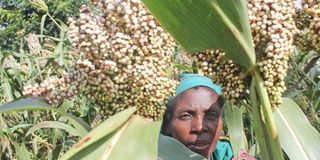Study: Millet diet can lower risk of type 2 diabetes

Ms Syprose Atieno inspects millet at her farm in Sidho, Muhoroni, of Kisumu County. A new study has shown that eating millet can reduce the risk of developing type 2 diabetes.
The study has also revealed that millet helps manage blood glucose levels in people with diabetes. The research was conducted in 11 countries and published in Frontiers in Nutrition.
The research further shows that diabetic people who consumed millet as part of their daily diet their blood glucose levels drop by between 12-15 per cent.
“The blood glucose bound to haemoglobin levels lowered on average 17 per cent for pre-diabetic individuals, and the levels went from pre-diabetic to normal status,” said the research findings.
“This systematic review of the studies published in scientific journals has proven that millets can keep blood glucose levels in check and reduce the risk of diabetes,” said Dr S Anitha, the study’s lead author and a Senior Nutrition Scientist at the International Crops Research Institute for the Semi-Arid Tropics (ICRISAT).
Type 2 diabetes
ICRISAT is an international organisation which conducts agricultural research for rural development. Investments in a few crops like rice, wheat and maize, have edged nutritious and climate-smart crops like millets out of the plate.
“Awareness of this ancient grain is just starting to spread globally and our review shows millets having a promising role in managing and preventing type 2 diabetes,” observed Professor Ian Givens, a co-author of the study and Director at University of Reading’s Institute of Food, Nutrition and Health (IFNH) in the United Kingdom.
According to the International Diabetes Association, diabetes is increasing in all regions of the world.
India, China and the US have the highest numbers of people with diabetes.
Africa has the largest forecasted increase of 143 per cent from 2019 to 2045, the Middle East and North Africa 96 percent and South East Asia 74 per cent.
The authors recommend the diversification of staples with millets to keep diabetes in check, especially across Asia and Africa.
“Millets are grown on all inhabited continents, yet they remain a ‘forgotten food’. We hope this will change from 2023, when the world observes the United Nations declared International Year of Millets, and with studies like this that show that millets outperform white rice, maize and wheat,” said Rosemary Botha, a co-author of the study who was based in Malawi at the time of the study, with the International Food Policy Research Institute (IFPRI).
“The global health crisis of under-nutrition and over-nutrition coexisting is a sign that our food systems need fixing. Greater diversity both on-farm and on-plate is the key to transforming food systems,” said Dr Jacqueline Hughes, Director General, ICRISAT.
Human health
“Millets are part of the solution to mitigate the challenges associated with malnutrition, human health, natural resource degradation, and climate change and lifestyle diseases like diabetes,” added Dr Hughes.
Professor Paul Inman, Pro-Vice-Chancellor (International) of the University of Reading, observed that: “The rapidly accelerating threats of climate change and global health crises, including obesity and diabetes, require everyone to pull together in action.”
This study is first in a series of studies that has been worked on for the last four years as a part of the Smart Food initiative led by ICRISAT that will be progressively released in 2021.
“The research aims at promoting the Smart Food vision of making our diets healthier, more sustainable for the environment and good for those who produce it,” explained Ms Joanna Kane-Potaka, a co-author from ICRISAT and Executive Director of the Smart Food initiative.





